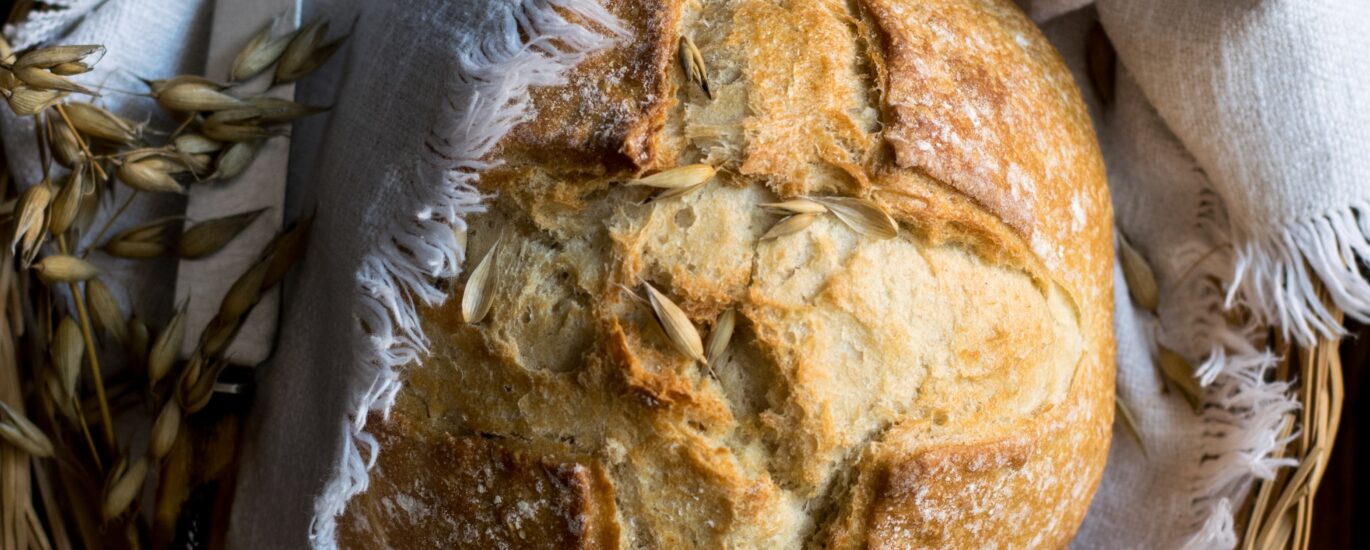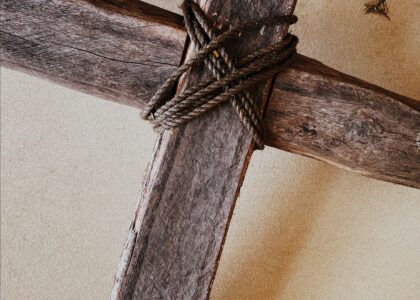The Lord’s Supper is a participation in the emblems of the body and blood of Jesus as an expression of faith in Him, our Lord and Saviour. In this experience of communion Christ is present to meet and strengthen His people. As we partake, we joyfully proclaim the Lord’s death until He comes again. Preparation for the Supper includes self-examination, repentance, and confession. The Master ordained the service of foot washing to signify renewed cleansing, to express a willingness to serve one another in Christlike humility, and to unite our hearts in love. The communion service is open to all believing Christians.—Fundamental Beliefs, 15
With dusty feet they arrived at the upper room for the Passover. Someone had provided a pitcher of water, a basin, and a towel for the customary footwashing, but no one wanted to perform the menial task.
Aware of His impending death, Jesus said sorrowfully, “‘With fervent desire I have desired to eat this Passover with you before I suffer; for I say to you, I will no longer eat of it until it is fulfilled in the kingdom of God'” (Luke 22:15, 16).
The jealousy the disciples harbored against one another filled Jesus’ heart with sadness. He realized they were still contending as to who should be considered the greatest in His kingdom (Luke 22:24; Matt. 18:1; 20:21). It was their maneuvering for position, their pride and self-esteem, that prevented the disciples from humbling themselves, from substituting for the servant and washing the feet of the others. Would they ever learn that in God’s kingdom true greatness is revealed by humility and loving service?
“During supper” (John 13:2, 4, RSV)1 Jesus quietly arose, took the servant’s towel, poured water into the basin, knelt down, and began to wash the disciples’ feet. The Master as servant! Understanding the unspoken rebuke, the disciples were filled with shame. When He had completed His work and returned to His place, He said, “‘If I then, your Lord and Teacher, have washed your feet, you also ought to wash one another’s feet. For I have given you an example, that you should do as I have done to you. Truly, truly, I say to you, a servant is not greater than his master; nor is he who is sent greater than he who sent him. If you know these things, blessed are you if you do them'” (John 13:14-17, RSV).
Jesus then instituted, in place of the Passover, the service that was to memorialize His great sacrifice: the Lord’s Supper. Taking the unleavened bread, He “blessed it and broke it, and
196
gave it to the disciples” and said, “‘Take, eat; this is My body which is broken for you; do this in remembrance of Me.'” Then He took the cup of blessing and “gave thanks, and gave it to them, saying, ‘Drink from it, all of you. For this is My blood of the new covenant, which is shed for many for the remission of sins.'” “‘This do, as often as you drink it, in remembrance of Me.’ For as often as you eat this bread and drink this cup, you proclaim the Lord’s death till He comes” (see Matt. 26:26-28; 1 Cor. 11:24-26; 10:16).
The ordinances of foot washing and the Lord’s Supper make up the Communion service. Thus, Christ instituted both of these ordinances to assist us with entering into communion with Him.
The Ordinance of Foot Washing
Custom demanded that in celebrating the Passover Jewish families remove all leaven, sin, from their homes before the first day of the Week of Unleavened Bread (Ex. 12:15, 19, 20). So believers must confess and repent of all sin—including pride, rivalry, jealousy, resentful feelings, and selfishness—before they can be in the right spirit to have communion with Christ at this deepest level.
To this end Christ instituted the ordinance of foot washing. Not only did He set an example but stated they ought to do the same, and promised them a blessing: “‘If you know these things, happy are you if you do them'” (John 13:17). This ordinance, preceding the Lord’s Supper, fulfills the injunction that all should examine themselves so as not to participate in that meal “in an unworthy manner” (1 Cor. 11:27-29).
The Meaning of the Ordinance. This ordinance reveals something about both Christ’s mission and the participants’ experience.
1. A memorial of Christ’s condescension. The ordinance of foot washing memorializes Christ’s humiliation in His incarnation and life of service.2 Although He held a position with the Father amidst celestial glory, He “made Himself of no reputation, taking the form of a servant, and coming in the likeness of men” (Phil. 2:7).
It was humiliating for God’s Son to give so selflessly, so lovingly, only to be rejected by the majority of those He came to save. Throughout Christ’s earthly life Satan was determined to disgrace Him to the utmost at every turn. What mortification it must have brought Him—the innocent One—to be crucified as a criminal!
Christ lived a life that was a life of selfless service. He did not come “‘to be served, but to serve'” (Matt. 20:28). Through the act of foot washing He showed that He would do any service, no matter how lowly, to save people. Thus He impressed His life of service and meekness on the minds of His followers.
In making this preparation ceremony an ordinance, Christ intended to lead believers into a state of tenderness and love that would move them to serve others.
197
This ordinance encourages those who reflect on its significance to treat others with humility and sensitivity. By following Christ in foot washing we profess His spirit: “Through love serve one another” (Gal. 5:13).
Though participation in this service is humbling, it is far from degrading. Who would not feel privileged to bow before Christ and wash the very feet that were nailed to the cross? Jesus said, “‘Inasmuch as you did it to one of the least of these My brethren, you did it to Me'” (Matt. 25:40).
2. A type of a higher cleansing. The foot washing did more than clean feet. It represented a higher purification—a cleansing of the heart. When Peter asked Jesus to wash him all over, Jesus said, “‘He who is bathed needs only to wash his feet, but is completely clean'” (John 13:10).
One who takes a bath is clean. However, open, sandaled feet soon become dusty and need washing again. So with the disciples. Their sins had been washed away through baptism, but temptation had led them to cherish pride, jealousy, and evil in their hearts. They were not ready to have intimate communion with their Lord, nor to accept the new covenant He was about to make with them. Through the foot washing Christ desired to prepare them to take part in the Lord’s Supper. Except for Judas, the betrayer, their hearts were cleansed by Christ’s grace from selfishness and pride, and they were united in love for one another; through Jesus’ selfless act they were humbled and became teachable.
Like the disciples, when we have accepted Christ and been baptized we have been cleansed by His blood. But as we walk the Christian life, we fail. Our feet become dusty. We must come to Christ again and let His cleansing grace wash away the defilement. However, we do not need to be baptized again for “he who is bathed needs only to wash his feet” (John 13:10).3 Foot washing as an ordinance reminds us of our need for regular cleansing and that we are totally dependent upon the blood of Christ. Foot washing itself cannot cleanse from sin. Only Christ can purify us.
3. A fellowship of forgiveness. The attitude of forgiveness among the participants indicates that the cleansing this service symbolizes has become effective. Only as we forgive can we experience God’s forgiveness. “If you forgive men their trespasses, your heavenly Father will also forgive you. But if you do not forgive men their trespasses, neither will your Father forgive your trespasses” (Matt. 6:14, 15).
Jesus said, “‘You also ought to wash one another’s feet'” (John 13:14). We need both to be willing to wash another’s feet and to be willing to be washed by another. In the latter case we admit our need of spiritual help.
When the service is over, our faith assures us that we are clean because our sins have been washed away. By whom? By Christ. But it is fellow believers who administer to us the symbols of Christ’s ministry and so this service becomes a fellowship of forgiveness.4
198
4. A fellowship with Christ and believers. This foot washing service demonstrates Christ’s love for His followers “to the end” (John 13:1). When Peter refused to have his feet washed Christ responded, “‘If I do not wash you, you have no part with Me'” (verse 8). No cleansing, no fellowship. Those desiring continuing fellowship with Christ will participate in this ordinance.
That same evening Jesus said, “‘A new commandment I give to you, that you love one another; as I have loved you, that you also love one another'” (verse 34). The message of the ordinance is clear: “Through love serve one another” (Gal. 5:13). Having this kind of love means that we will concede the highest place to our neighbors by esteeming others better than ourselves (Phil 2:3). It mandates us to love those who differ with us. It allows us to hold neither feelings of supremacy nor partiality. Our lifestyles will reflect our love for fellow believers. Kneeling before them, washing their feet, we rejoice that we will live with them throughout eternity. All who follow Christ’s example in this ordinance will in some way experience what it means to love as Christ loved. And such love can be a powerful witness.
A Buddhist monk once asked a missionary to suggest a scene that would represent Christianity. Artists were to decorate a hall on the monastery grounds with murals and reliefs that depicted major world religions. After some reflection the missionary began to share the account in John 13. The monk “said nothing as I read,” the missionary recounted, “but I felt a strange, awesome quietness and power as the passage described Jesus’ act of washing the disciples’ feet.” In that culture, discussing in public anything having to do with matters of the feet is considered very poor etiquette.
“When I finished reading, there was a moment of silence. He looked at me with incredulity and said, ‘Do you mean to say that the Founder of your religion washed His students’ feet?’
“‘Yes,’ I replied. The usually placid moon face with shaved eyebrows and head wrinkled up in shock and amazement. He was speechless, and so was I. I swallowed very hard several times, and we were both caught up in the drama of the scene. As I gazed at him, the look of incredulity on his face changed to a reverent awe. Jesus, the Founder of Christianity, had touched and washed dirty fishermen’s feet! After a few moments he gained control of himself and rose to his feet. ‘I see now the essence of Christianity.'”5
The Celebration of the Lord’s Supper
Among Protestants the most common name for the Communion service is the “Lord’s Supper” (1 Cor. 11:20). Other names are “the table of the Lord” (1 Cor. 10:21, RSV), “the breaking of bread” (cf. Acts 20:7; 2:42),6 and the Eucharist—a reference to the thanksgiving and blessing aspect of the service (Matt. 26:26, 27; 1 Cor. 10:16; 11:24).
199
The Lord’s Supper is to be a joyful season, not a time for sorrow. The preceding foot-washing service provides an opportunity for self-examination, confession of sins, reconciliation of differences, and forgiveness. Having received the assurance of being cleansed by the blood of the Saviour, believers are ready to enter into special communion with their Lord. They turn to His table with joy, standing in the saving light, not the shadow, of the cross, ready to celebrate the redemptive victory of Christ.
The Meaning of the Lord’s Supper. The Lord’s Supper replaces the Passover festival of the old covenant era. The Passover met its fulfillment when Christ the Paschal Lamb gave His life. Before His death Christ Himself instituted the replacement, the great festival of spiritual Israel under the new covenant. Thus, the roots of much of the symbolism of the Lord’s Supper extend back into the Passover service.
1. Commemoration of the deliverance from sin. As the Passover festival commemorated Israel’s deliverance from slavery in Egypt, the Lord’s Supper commemorates deliverance from spiritual Egypt, the bondage of sin.
The Passover lamb’s blood applied to the lintel and doorposts protected the inhabitants from death; the nourishment its flesh provided gave them the strength to escape from Egypt (Ex. 12:3-8). So Christ’s sacrifice brings liberation from death; believers are saved through partaking of both His body and blood (John 6:54). The Lord’s Supper proclaims that Christ’s death on the cross provided our salvation, provided forgiveness, and guaranteed eternal life.
Jesus said, “‘Do this in remembrance of Me'” (1 Cor. 11:24). This ordinance emphasizes the substitutionary dimension of Christ’s atonement. “‘This is My body, ‘” Jesus said, “‘which is broken for you'” (1 Cor. 11:24; cf. Isa. 53:4-12). At the cross the Innocent was substituted for the guilty, the Righteous for the unrighteous. This magnanimous act satisfied the demands of the law for the death of the sinner, providing forgiveness, peace, and the assurance of eternal life to repentant sinners. The cross removed our condemnation and provided us with the robe of Christ’s righteousness and with the power to overcome evil.
a. The bread and the fruit of the vine. Jesus used many metaphors to teach different truths about Himself. He said, “‘I am the door'” (John 10:7), “‘I am the way'” (John 14:6), “‘I am the true vine'” (John 15:1), and “‘I am the bread of life'” (John 6:35). We cannot take any of these expressions literally, for He is not present in every door, way, or vine. Instead, they illustrate deeper truths.
At the time He miraculously fed the 5, 000, Jesus revealed the deeper significance of His body and blood. As the true bread, He said, “‘Moses did not give you the bread from heaven, but My Father gives you the true bread from heaven.
200
For the bread of God is He who comes down from heaven and gives life to the world.’ Then they said to Him, ‘Lord, give us this bread always.’ And Jesus said to them, ‘I am the bread of life. He who comes to Me shall never hunger, and he who believes in me shall never thirst'” (John 6:32-35). He offered His body and blood to satisfy the hunger and thirst of our deepest needs and desires (John 6:50-54).
The Passover bread Jesus ate was unleavened, and the fruit of the vine unfermented.7 Leaven (yeast), which produces fermentation that causes bread to rise, was considered a symbol of sin (1 Cor. 5:7, 8), so it was unfit to represent the Lamb “without blemish and without spot” (1 Peter 1:19).8 Only unleavened or “unfermented” bread could symbolize the sinless body of Christ. Likewise only the unspoiled fruit of the vine—the unfermented wine—appropriately symbolizes the spotless perfection of the cleansing blood of the Saviour.9
b. The eating and drinking. “‘Unless you eat the flesh of the Son of Man and drink His blood, you have no life in you. Whoever eats My flesh and drinks My blood has eternal life, and I will raise him up at the last day'” (John 6:53, 54).
Eating Christ’s flesh and drinking His blood is symbolic language for the assimilation of the Word of God, through which believers maintain communion with heaven and are enabled to have spiritual life. He says, “‘The words that I speak to you are spirit, and they are life'” (John 6:63). “‘Man shall not live by bread alone, but by every word that proceeds from the mouth of God'” (Matt. 4:4).
Believers feed on Christ, the bread of life, through partaking of the Word of life—the Bible. With that Word comes Christ’s life-giving power. In the Communion service also we partake of Christ by assimilating His Word through the Holy Spirit. For this reason the preaching of the Word accompanies each Lord’s Supper.
Since we appropriate the benefits of Christ’s atoning sacrifice by faith, the Lord’s Supper is much more than a mere memorial meal. Participation in the Communion service means a revitalization of our life through Christ’s sustaining power, providing us with life and joy. In short the symbolism shows that “we are as dependent on Christ for spiritual life as we are on food and drink for physical life.”10
During the Communion service we “bless” the cup (1 Cor. 10:16). This means that as Christ “gave thanks” for the cup (Matt. 26:27), so we express gratitude for the blood of Jesus.
2. Corporate communion with Christ. In a world filled with strife and divisiveness, our corporate participation in these celebrations contributes to the unity and stability of the church, demonstrating true communion with Christ and one another. Stressing this communion, Paul said, “The cup of blessing which we bless, is it not a participation [or communion] in the blood of Christ? The bread which we break, is it not a participation [or communion] in the body of Christ?
201
Because there is one bread, we who are many are one body, for we all partake of the one bread” (1 Cor. 10:16, 17, RSV).
“This is an allusion to the fact that the communion bread is broken into many pieces, which are eaten by the believers, and as all the pieces come from the same loaf, so all the believers who partake of the communion service are united in Him whose broken body is thus typified by the broken bread. By partaking together of this ordinance, Christians show publicly that they are united and belong to one great family, whose head is Christ.”11
All church members should participate in this sacred Communion because there, through the Holy Spirit, “Christ meets His people, and energizes them by His presence. Hearts and hands that are unworthy may even administer the ordinances, yet Christ is there to minister to His children. All who come with their faith fixed upon Him will be greatly blessed. All who neglect these seasons of divine privilege will suffer loss. Of them it may appropriately be said, ‘Ye are not all clean.'”12
We experience the strongest and deepest sense of community at the Lord’s table. Here we meet on common ground, with the barriers that separate us broken down. Here we realize that while in society there is much to divide us, in Christ there is everything necessary to unite us. While sharing the Communion cup Jesus committed the new covenant to His disciples. Said He, “‘Drink from it, all of you. For this is My blood of the new covenant which is shed for many for the remission of sins'” (Matt. 26:27, 28; cf. Luke 22:20). As the old covenant was ratified by the blood of animal sacrifices (Ex. 24:8), so the new covenant was ratified by Christ’s blood. At this ordinance believers renew their pledge of loyalty to their Lord, recognizing anew that they are a part of the amazing agreement by which, in Jesus, God bound Himself to humanity. Being a part of this covenant, they have something to celebrate. So the Lord’s Supper is both a memorial and a thanksgiving of the sealing of the everlasting covenant of grace. The blessings received are in proportion to the faith of the participants.
3. Anticipation of the Second Advent. “For as often as you eat this bread and drink this cup, you proclaim the Lord’s death till He comes” (1 Cor. 11:26). The Communion service spans the interim between Calvary and the Second Advent. It links the cross and the kingdom. It joins the “already” and the “not yet,” which is the essence of the New Testament world view. It holds together the Saviour’s sacrifice and His second coming—salvation provided and salvation consummated. It proclaims that Christ is present through the Spirit till He comes visibly.
Christ’s vow, “‘I will not drink of this fruit of the vine from now on until that day when I drink it new with you in My Father’s kingdom'” (Matt. 26:29), is prophetic. It directs our faith to a future celebration of the Communion meal with
202
our Saviour in the kingdom. The occasion is the great festival of the “marriage supper of the Lamb” (Rev. 19:9).
In preparation for this event Christ instructed, “‘Let your waist be girded and your lamps burning; and you yourselves be like men who wait for their master, when he will return from the wedding, that when he comes and knocks they may open to him immediately. Blessed are those servants whom the master, when he comes, will find watching. Assuredly, I say to you that he will gird himself and have them sit down to eat, and will come and serve them'” (Luke 12:35-37).
With His followers gathered at the banquet table Christ will celebrate the Supper as He did in Jerusalem. For so long He has waited for this occasion, and now all is ready. He arises from His throne and steps forward to serve. Amazement fills all. They feel totally unworthy of the honor of having Christ serve them. They protest, saying, “Let us serve!” But Christ quietly insists and has them sit down.
“Never was Christ truly greater on earth than on the memorable occasion of the Lord’s Supper, when He took the place of a servant and humbled Himself. Never is Christ greater in heaven than when He ministers to His saints.”13 This is the climactic expectation to which the Lord’s Supper points us, the joy of future glory through a personal fellowship with Christ in His everlasting kingdom.
Qualifications for Participation. Two great ordinances serve the Christian faith—baptism and the Lord’s Supper. The former is the gateway into the church, and the latter benefits those who are members.14 Jesus administered Communion only to His professed followers. The Communion service, therefore, is for believing Christians. Children do not customarily participate in these ordinances unless they are baptized.15
The Bible instructs believers to celebrate this ordinance with due reverence for the Lord, for the one who “eats this bread and drinks this cup. . . in an unworthy manner will be guilty of the body and blood of the Lord” (1 Cor. 11:27). This “unworthy manner” consists “either in unbecoming conduct (see verse 21) or in a lack of vital, active faith in the atoning sacrifice of Christ.”16 Such behavior shows disrespect to the Lord and can be considered a rejection of the Saviour and so a sharing in the guilt of those who crucify Him.
Improper participation brings about God’s displeasure. Those eating and drinking in an unworthy manner eat and drink “judgment” to themselves, “not discerning the Lord’s body” (1 Cor. 11:29). They fail to distinguish between ordinary food and the consecrated emblems that symbolize Christ’s atoning death. “Believers must not treat the ordinance as merely a commemorative ceremony of a happening in history. It is that, and much more; it is a reminder of what sin has cost God and what man owes to the Saviour. It is also a means of keeping fresh in mind the believer’s duty to bear public witness to his faith in the atoning death of the Son of God.”17
203
In view of these admonitions Paul counsels the believer to “examine himself” before participating in the Lord’s Supper (1 Cor. 11:28). Before taking part believers should prayerfully review their Christian experience, confessing their sins and restoring severed relationships.
The experience of the Adventist pioneers reveals what a blessing such an examination can provide: “When our numbers were few, the celebration of the ordinances was made a most profitable occasion. On the Friday before, every church member endeavored to clear away everything that would tend to separate him from his brethren and from God. Hearts were closely searched; prayers for a divine revelation of hidden sin were earnestly offered; confessions of over-reaching in trade, of ill-advised words hastily spoken, of sin cherished, were made. The Lord came near, and we were greatly strengthened and encouraged.”18
This examination is a personal work. Others cannot do it, for who can read the heart or distinguish the weeds from the wheat? Christ, our example, rejected exclusiveness at the Supper. Though open sin excludes persons from participating (1 Cor. 5:11), Jesus Himself shared the meal with Judas—outwardly a professed follower, inwardly a thief and traitor.
What marks those who are qualified to participate in the Communion service, then, is the condition of the heart—a full commitment to Christ and faith in His sacrifice, not membership in any particular church. Consequently, believing Christians of all churches can take part in the Lord’s Supper. All are invited to celebrate often this great festival of the new covenant, and through their participation to witness to their acceptance of Christ as a personal Saviour.19
References
1 See Robert Odom, “The First Celebration of the Ordinance of the Lord’s House,” Ministry, Jan. 1953, p. 20; White, Desire of Ages, pp. 643-646.
2 Ibid, p. 650.
3 There is a relationship between baptism and the Lord’s Supper. Baptism precedes church membership, while the foot washing serves those who already are church members. During this ordinance we may appropriately meditate on our baptismal vows.
4 See C. Mervyn Maxwell, “A Fellowship of Forgiveness,” Review and Herald, June 29, l961, pp. 6, 7.
5 Jon Dybdahl, Missions: A Two-Way Street (Boise, ID: Pacific Press, 1986), p. 28.
6 Though it is generally understood that in Acts 20:7 the expression refers to the celebration of the Lord’s Supper, it does not exclusively refer to this ordinance. In Luke 24:35 it refers to a common daily meal.
7 On the assumption that the people of Bible times could not have preserved grape juice for an extended period of time in the warm climate of Israel from the time of the fall grape harvest until the Passover in the spring it is taken for granted that the Jews celebrated the Passover with fermented wine. This assumption is unwarranted. Throughout the ancient world juices were often preserved in an unfermented state for extended periods through various methods. One method was to concentrate the juice to a syrup by boiling it. Stored in a cool place, this concentrate would not ferment. Simply diluting it with water yielded a non-alcoholic “sweet wine.” See William Patton, Bible Wines—Laws of Fermentation (Oklahoma City, OK: Sane Press, n.d.), pp. 24-41; see also C.A. Christoforides, “More on Unfermented Wine,” Ministry, April 1955, p. 34; Lael O. Caesar, “The Meaning of Yayin in the Old Testament” (Unpublished M.A. Thesis).
204
Andrews University, 1986), pp. 74-77; White, Desire of Ages, p. 653. The Passover wine could also be made from raisins (F.C. Gilbert, Practical Lessons From the Experience of Israel for the Church of To-day [Nashville, TN: Southern Publ. Assn., 1972 ed.], pp. 240, 241).
8 In this light it is not without significance that Christ avoids using the usual word for wine (Greek, oinos) but employs the phrase “the fruit of the vine” (Mark 14:25). While oinos can refer to wine in its fermented, as well as its unfermented, state, the fruit of the vine refers to the pure juice—a fitting symbol of the blood of Christ, who calls Himself the “True Vine” (John 15:1).
9 Yeast also causes the fermentation of grape juice. Yeast spores, carried freely through the air or by insects, attach themselves to the wax coat of the grape skins. When the grapes are crushed the spores mix with the juice. At room temperature the yeast cells multiply rapidly, fermenting the wine (see Martin S. Peterson, Arnold H. Johnson, eds., Encyclopedia of Food Technology [Westport, CT.: Avi Publishing Co., 1974], vol. 2, pp. 61-69; idem, Encyclopedia of Food Science [Westport, CT: Avi Publishing Co., 1978], vol. 3, p. 878).
10 R. Rice, Reign of God, p. 303.
11 SDA Bible Commentary, rev. ed., vol. 6, p. 746.
12 White, Desire of Ages, p. 656; cf. p. 661.
13 M.L. Andreasen, “The Ordinances of the Lord’s House,” Ministry, Jan. 1947, pp. 44, 46.
14 Cf. White, Evangelism (Washington, D.C.: Review and Herald, 1946), p. 273.
15 See e.g. Frank Holbrook, “For Members Only?” Ministry, Feb. 1987, p. 13.
16 SDA Bible Commentary, rev. ed., vol. 6. p. 765.
17 Ibid.
18 White, Evangelism, p. 274; cf. SDA Bible Commentary, rev. ed., vol. 6, p. 765.
19 The Bible does not specify how frequently the Lord’s Supper should be celebrated (see 1 Cor. 11:25, 26). Adventists have followed the practice of many Protestants to have this ordinance four times a year. “In adopting the quarterly plan, the early Advent believers felt that in holding the service more frequently there would be the danger of formality and failure to realize the solemnity of the service.” It seems to be a middle-of-the-road decision—between celebrating it too often and leaving it for too long a period, such as once a year (W.E. Read, “Frequency of the Lord’s Supper,” Ministry, April 1955, p. 43).
http://www.sdanet.org/atissue/books/27/27-15.htm






